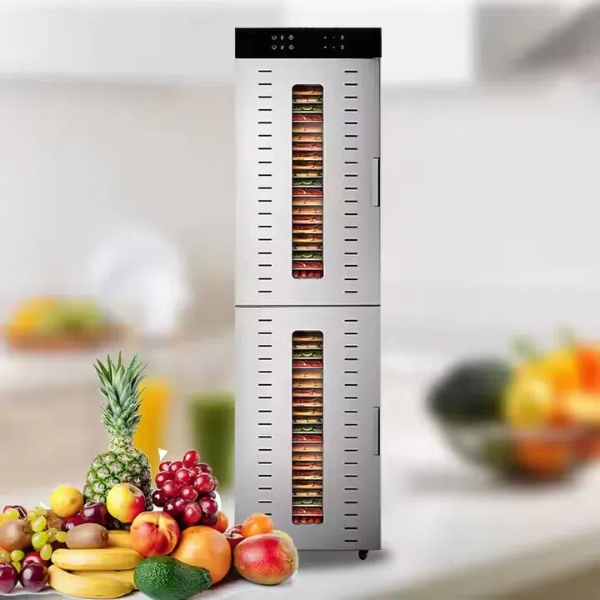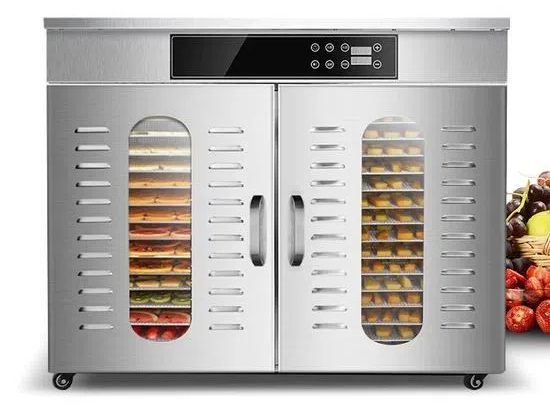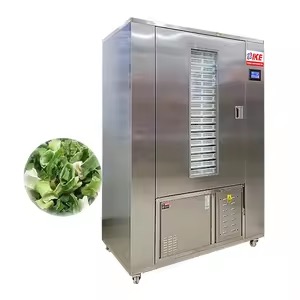
Content Menu
● Understanding Cabinet Type Dehydrators
>> Key Features of Cabinet Dehydrators
>> Types of Cabinet Dehydrators
● Preparing Fruits and Vegetables for Dehydration
>> Step-by-Step Preparation Guide
● The Dehydration Process
>> Using a Cabinet Dehydrator
>> Tips for Optimal Dehydration
● Applications of Cabinet Dehydrators
● OEM Services for Food Dehydrators
>> Benefits of OEM Services
>> Key Considerations for Choosing an OEM Partner
● Optimizing Cabinet Dehydrators for Fruits and Vegetables
>> Understanding the Role of Airflow
>> Advanced Techniques for Enhancing Dehydration
● Using Dehydrated Food for Cooking
>> Step-by-step Guide
● Conclusion
● FAQ
>> 1. What are the main advantages of using a cabinet type dehydrator over other types of dehydrators?
>> 2. How do I choose the right temperature and drying time for different fruits and vegetables?
>> 3. What are some common mistakes to avoid when dehydrating fruits and vegetables?
>> 4. How can OEM services benefit my business in the food dehydrator market?
>> 5. What certifications should I look for when choosing an OEM partner for food dehydrators?
● Citations:
Dehydrating fruits and vegetables is an age-old method of food preservation, enhancing shelf life while retaining valuable nutrients and flavors. In today's market, cabinet type dehydrators have emerged as a popular choice for both commercial and home use, offering efficiency, consistency, and versatility. This comprehensive guide explores the ins and outs of using cabinet dehydrators, particularly for fruits and vegetables, while also touching on OEM (Original Equipment Manufacturer) services for businesses looking to produce their own branded dehydrators.

Understanding Cabinet Type Dehydrators
A cabinet type dehydrator is a self-contained unit designed to remove moisture from food products, extending their shelf life and preserving their natural qualities. Unlike simpler dehydrators, cabinet models provide a controlled environment that ensures uniform drying, resulting in superior product quality and minimal waste. These machines integrate a heat pump dryer with a precisely controlled chamber to optimize performance and maximize energy efficiency.
Key Features of Cabinet Dehydrators
-High Efficiency: Ensures consistent dehydration while minimizing energy waste.
-Capacity: Suitable for small-to-medium-scale operations, handling batches from 100kg to 1000kg.
-Integrated Design: Optimizes performance and energy utilization.
-Versatility: Can dry a wide range of foods, including fruits, vegetables, meats, herbs, and spices.
Types of Cabinet Dehydrators
1. Stackable Dehydrators: These feature vertically stacked trays with the heating element and fan at the bottom or top. They are budget-friendly but may require manual tray rotation for even drying. While they can be suitable for small batches, their inconsistency can be a significant drawback for commercial applications requiring uniform results.
2. Cabinet (Box-Type) Dehydrators: Designed for larger-scale operations, offering superior control and consistency. They have a fully enclosed cabinet with trays that slide in and out, ensuring even heat distribution. These are the preferred choice for businesses and serious home users.
Preparing Fruits and Vegetables for Dehydration
Before using a cabinet dehydrator, proper preparation of fruits and vegetables is crucial. This ensures not only the safety of the final product but also its quality in terms of taste, texture, and appearance.
Step-by-Step Preparation Guide
1. Selection: Choose fresh, ripe fruits and vegetables. Avoid produce with bruises, blemishes, or signs of decay, as these can affect the final product's quality and shelf life.
2. Cleaning: Thoroughly wash produce to remove dirt and debris. Use a vegetable brush to scrub the skins of root vegetables.
3. Peeling and Cutting: Peel if desired, remove pits or seeds, and cut into uniform sizes. Uniform slicing ensures even drying; aim for slices that are approximately the same thickness. Using a mandoline or a food processor can help achieve consistent results, especially for large batches.
4. Pre-treatment: Some fruits and vegetables require blanching to prevent discoloration and kill enzymes. This step is critical for maintaining the nutritional value and color of certain produce.
-Blanching: A 1-minute bath in boiling water followed by submersion in ice water. The boiling water deactivates enzymes that can cause discoloration, while the ice water stops the cooking process.
-Fruits that require blanching: Apricots, cherries, grapes, plums, and rhubarb.
-Vegetables that require blanching or cooking: Artichokes, asparagus, green beans, beets, broccoli, Brussels sprouts, cabbage, carrots, cauliflower, celery, collards, corn, fennel bulb, okra, parsnips, peas, potatoes, pumpkin and winter squash, sweet potatoes, and Swiss chard.
5. Arranging on Trays: Place the prepared items on the dehydrator trays in a single layer, ensuring good air circulation. Avoid overlapping pieces, as this can impede drying. If necessary, use mesh liners on the trays to prevent smaller pieces from falling through.
The Dehydration Process
Using a Cabinet Dehydrator
1. Loading the Dehydrator: Load the prepared trays into the cabinet dehydrator. Ensure that the trays are properly aligned and that the cabinet door is securely closed.
2. Setting Temperature and Time: Follow the manufacturer's recommendations for temperature and drying time, adjusting based on the type and thickness of the produce. Consider factors such as humidity and altitude, which can affect drying times.
3. Monitoring: Regularly check the food for dryness. Rotate trays if necessary to ensure even drying. Some cabinet dehydrators have automatic rotation features, which can save time and effort.
4. Testing for Dryness: The food should be brittle and break under pressure, or papery with no remaining moisture. Perform a "squeeze test" to check for residual moisture; if the food feels pliable or sticky, it needs more drying time.

Tips for Optimal Dehydration
-Temperature Control: Maintain a consistent temperature throughout the drying process. Use a thermometer to verify the internal temperature of the dehydrator, especially in older models where temperature settings may be inaccurate.
-Air Circulation: Ensure proper air circulation within the dehydrator. Avoid blocking air vents and ensure that the trays are not overcrowded.
-Even Slicing: Consistent slice sizes promote uniform drying. Use a mandoline or food processor to achieve uniformity, especially for large batches.
-Proper Loading: Avoid overcrowding the trays to allow adequate airflow. Overcrowding can lead to uneven drying and increase the risk of spoilage.
-Humidity Control: If the humidity in your environment is high, consider using a dehumidifier in the room where the dehydrator is located. This can help speed up the drying process and prevent mold growth.
Applications of Cabinet Dehydrators
Cabinet dehydrators are versatile tools used across various industries:
-Food Processing: Creating dried fruits, vegetable chips, fruit leathers, and meat jerky. These dehydrated products can be sold as snacks, ingredients, or emergency food supplies.
-Snacks and Ingredients: Producing healthy snacks and ingredients with long shelf lives. Dehydrated fruits and vegetables are popular choices for trail mixes, granola bars, and other healthy snacks. They can also be used as ingredients in soups, stews, and sauces.
-Emergency Food Supplies: Preparing portable and durable emergency food. Dehydrated foods are lightweight, compact, and have a long shelf life, making them ideal for emergency food kits.
-Herbs and Spices: Drying herbs and spices to preserve their flavor and aroma. Home gardeners can use cabinet dehydrators to dry their homegrown herbs, ensuring a steady supply of fresh, flavorful spices throughout the year.
-Pet Treats: Making healthy and natural pet treats. Dehydrated sweet potatoes, chicken jerky, and beef liver are popular choices for pet treats.
OEM Services for Food Dehydrators
For businesses looking to offer their own branded food dehydrators, OEM services provide a comprehensive solution. This allows companies to enter the market without the need for expensive manufacturing infrastructure.
Benefits of OEM Services
-Customization: Tailor the design and features to meet specific market needs. You can customize everything from the size and shape of the dehydrator to the materials used in its construction.
-Cost-Effectiveness: Reduce manufacturing costs by leveraging established production facilities. OEM manufacturers often have economies of scale that allow them to produce dehydrators at a lower cost than if you were to manufacture them yourself.
-Quality Control: Ensure high standards through rigorous quality control processes. Reputable OEM manufacturers have quality control systems in place to ensure that every dehydrator meets your specifications.
-Scalability: Easily scale production to meet increasing demand. OEM manufacturers can quickly ramp up production to meet your growing needs, allowing you to focus on marketing and sales.
-Innovation: Access to the latest technologies and manufacturing techniques. OEM manufacturers are often at the forefront of innovation in their industry, giving you access to the latest technologies and manufacturing techniques.
-Reduced Risk: Minimizes investment in equipment, facilities, and personnel. By outsourcing manufacturing to an OEM partner, you can avoid the significant capital investment required to set up your own production facility.
Key Considerations for Choosing an OEM Partner
1. Experience and Expertise: Look for a manufacturer with a proven track record in producing high-quality dehydrators. Check their portfolio and ask for references from other clients.
2. Production Capabilities: Ensure the factory has the capacity and technology to meet your production needs. Visit the factory to assess their capabilities and ensure that they have the equipment and personnel to meet your requirements.
3. Quality Assurance: Verify that the manufacturer has robust quality control systems in place. Ask for documentation of their quality control processes and audit their facilities to ensure that they meet your standards.
4. Certifications: Check for relevant certifications, such as ISO 9001, to ensure compliance with international standards. Certifications demonstrate that the manufacturer is committed to quality and adheres to industry best practices.
5. Communication and Support: Choose a partner who offers excellent communication and support throughout the OEM process. Clear and timely communication is essential for a successful OEM partnership.
6. Intellectual Property Protection: Ensure that the manufacturer has measures in place to protect your intellectual property. A non-disclosure agreement (NDA) is a standard practice to protect your confidential information.
7. Pricing and Payment Terms: Negotiate fair pricing and payment terms. Understand the manufacturer's pricing structure and payment schedule before signing a contract.
8. Lead Times: Understand the manufacturer's lead times for production and delivery. Ensure that their lead times align with your business needs.
Optimizing Cabinet Dehydrators for Fruits and Vegetables
Understanding the Role of Airflow
Airflow is the unsung hero of the dehydration process. Consistent and even airflow ensures that moisture is removed uniformly from all surfaces of the food. Poor airflow can lead to uneven drying, mold growth, and compromised product quality.
Advanced Techniques for Enhancing Dehydration
-Pulsed Dehydration: Some advanced dehydrators offer a pulsed dehydration mode, alternating between heating and cooling cycles. This can help prevent case hardening and improve the overall texture of the dried product.
-Humidity Sensing: High-end cabinet dehydrators may include humidity sensors that automatically adjust the drying parameters based on the moisture content of the food.
-Automatic Tray Rotation: Automatic tray rotation systems ensure even drying without manual intervention.
Using Dehydrated Food for Cooking
Step-by-step Guide
1. Fruits: Fruits are often delicious raw and in a dehydrated state. To rehydrate most fruits place in a bowl of lukewarm water for 15 minutes. They can be eaten fresh or used in any recipe that needs fruit.
2. Vegetables: To rehydrated vegetables place them in a bowl and cover them with boiling water. It usually only takes 15 minutes to rehydrate, but there are a few stubborn vegetables like peppers that will take a bit longer.
3. Soups: Just put the vegetables right in without rehydrating.
Conclusion
Cabinet type dehydrators offer an efficient and reliable method for preserving fruits and vegetables, suitable for both home and commercial use. For businesses, leveraging OEM services can provide a cost-effective way to offer customized dehydrators under their own brand. By understanding the dehydration process, choosing the right equipment, and partnering with a reputable OEM manufacturer, you can create high-quality dehydrated products that meet market demands.

FAQ
1. What are the main advantages of using a cabinet type dehydrator over other types of dehydrators?
Cabinet type dehydrators offer superior control and consistency, ensuring uniform drying and high product quality. They are also more energy-efficient and suitable for larger-scale operations compared to stackable dehydrators. The controlled environment, consistent temperature, and air circulation are significant advantages.
2. How do I choose the right temperature and drying time for different fruits and vegetables?
Refer to the dehydrator's manual for recommended temperatures and drying times. Generally, fruits require lower temperatures (around 135°F or 57°C) and longer drying times, while vegetables need slightly higher temperatures (around 145°F or 63°C). Adjust based on the thickness and moisture content of the produce. Experimentation and careful monitoring are crucial.
3. What are some common mistakes to avoid when dehydrating fruits and vegetables?
Common mistakes include overcrowding the trays, not ensuring even slicing, failing to blanch certain produce, and not monitoring the drying process. Proper preparation and consistent monitoring are key to successful dehydration. Also, avoid using produce that is not fresh, or that has blemishes.
4. How can OEM services benefit my business in the food dehydrator market?
OEM services allow you to customize and brand your own food dehydrators without the need for in-house manufacturing facilities. This reduces costs, ensures quality control, and allows you to focus on marketing and sales. It's a faster, more cost-effective way to enter the market.
5. What certifications should I look for when choosing an OEM partner for food dehydrators?
Look for certifications such as ISO 9001, which ensures the manufacturer complies with international quality management standards. Additional certifications may include food safety and energy efficiency standards relevant to your target market. Also, ensure they comply with local regulations in your target market.
Citations:
[1] https://repository.cpu.edu.ph/handle/20.500.12852/1187
[2] https://www.youtube.com/watch?v=PA5ZU85a6ns
[3] https://patents.google.com/patent/CN201919616U/zh
[4] https://www.dryeratech.com/the-ultimate-guide-to-cabinet-type-dehydrator-machines.html
[5] https://www.theseasonalhomestead.com/food-dehydration-101-drying-fruits-and-vegetables/
[6] https://patents.google.com/patent/CN110207480A/zh
[7] https://drybox.in/cabinet-type-dehydrator/
[8] https://winecountrytable.com/eat-drink/chefs-tips/the-art-of-dehydrating-fruit-vegetables-and-herbs-a-chefs-guide/











